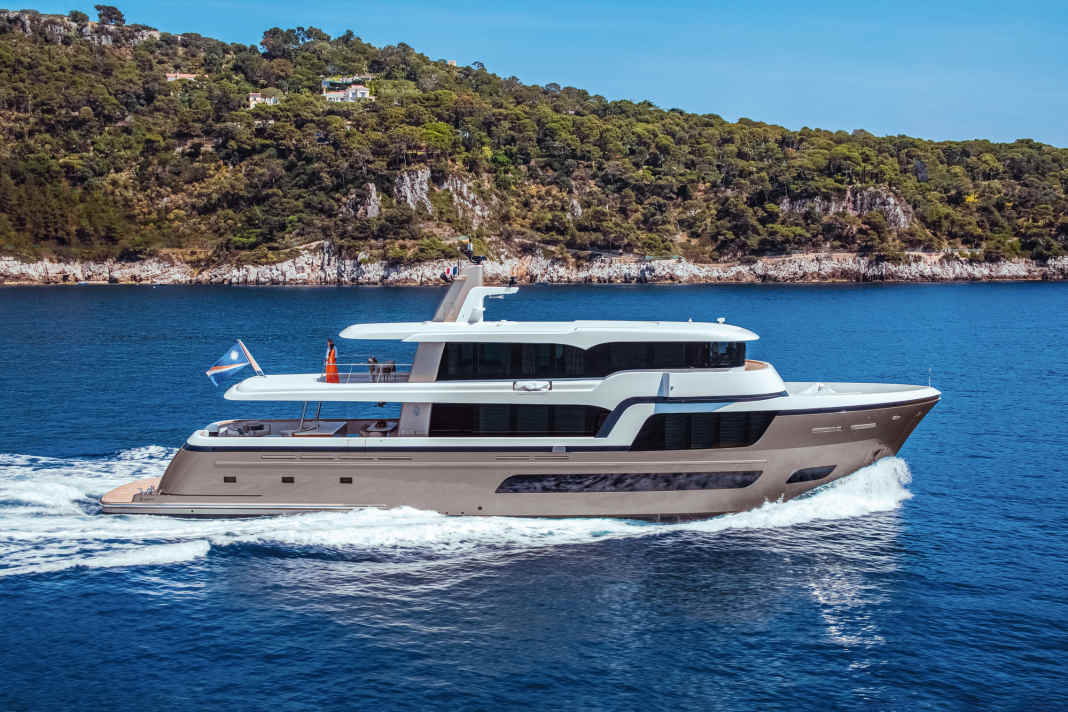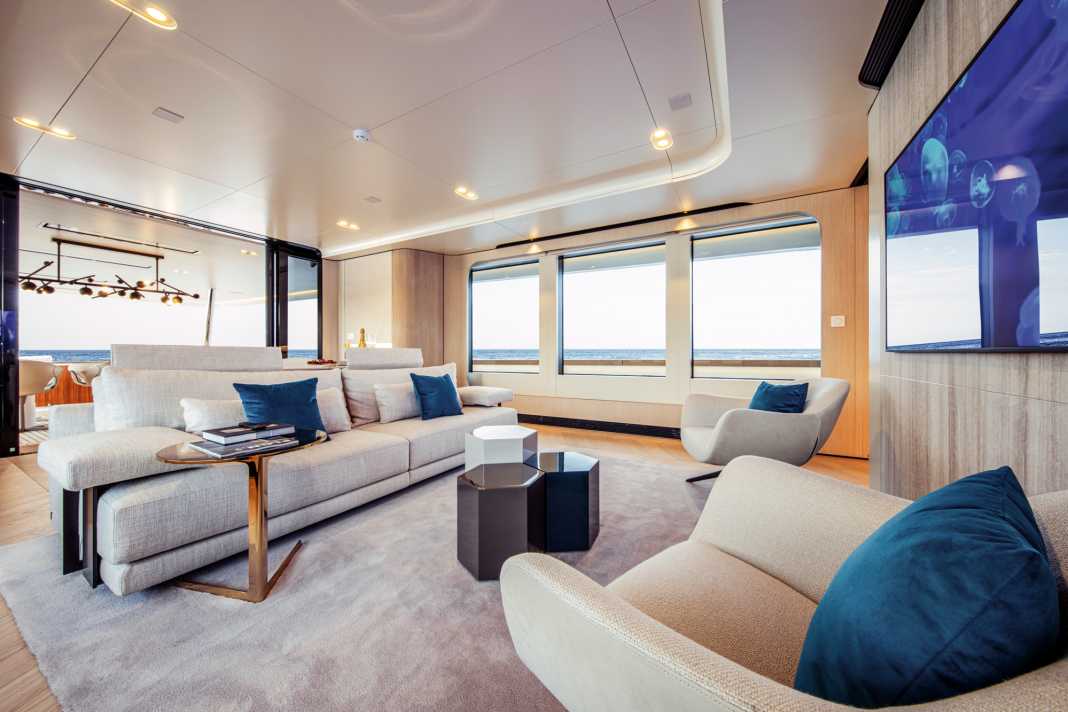





The path from a yacht's desire to the right shipyard can be very short, eliminating long searches for the ideal building site and time-consuming quality comparisons. "We have already built the 90-footer 'LeVen' for this family," explains Bram Kooltjes, Managing Director of Van der Valk, "and now the parents of this owner wanted their own custom yacht, around 24 metres." However, the clients of "Lady Lene" had already reached a respectable age and so the list of requirements for the Dutch shipyard was filled with numerous points that can be summarised as "spacious and above-average comfort" through to "barrier-free". "A large aft deck, separate dining room, panoramic deck," Kooltjes lists, "but above all, the layout had to be fully wheelchair accessible."
This meant a multifunctional gangway, extra-wide passageways, zero steps and, of course, a lift from the lower to the upper deck, where the grandmother wanted to set up her own realm. The designers from Diana Yacht Design and Ginton Naval Architects and the designer Guido de Groot quickly reached their limits with the originally envisaged dimensions. As a result, the concept for the lady became longer and longer, and the wishes could finally be accommodated in a 34 metre - and eight metre wide - space. The aluminium yacht was not to be any larger, and certainly not deeper for the Bahamas, their favourite destination.
"Lady Lene" realised within two years
The owners did not want to wait long for their floating holiday villa, nor did they have to. It took less than two years from the first sketches in December 2019 to delivery in November 2021 - a very tight schedule. Guido de Groot, responsible for the elegant, soft exterior lines, puts it like this: "very special." No wonder that two design offices were engaged, working in parallel and looking over each other's shoulders. "That makes a yacht even better in the end," emphasises Hans-Maarten Bais, Creative Director of Diana Yacht Design.
"Lady Lene" kept even the experienced team on their toes. For barrier-free living at sea, you can't simply leave out all the thresholds and steps; the classification society RINA requires water protection barriers in various places, such as between the cockpit and saloon. In addition, the headroom ordered - the ceiling height in the saloon is 2.50 metres - required some rethinking: "We needed a clever design, after all, the space above the ceilings shouldn't be too generous," says Bais. Otherwise, the lady threatened to grow too high.
One challenge follows the next
However, the biggest challenge lay elsewhere. The original design envisaged small windows, more like portholes, in the hull. "When we were finished with everything, the customer said that he had seen something very beautiful on another yacht," reports Bais. "He now also wanted such large windows for the lower deck." So that meant reworking the hull design again and changing all the plans. The owner's announcement came on a Friday, and the welding machines were due to start on the following Tuesday. Postponing the schedule was out of the question. Bais and his colleagues took it in their stride. Nevertheless, they will remember the workload of this weekend for a long time to come.



Jaron Ginton was responsible for everything below the waterline. The designer raves about the "Carte Blanche" he received for the hull design and gave the displacer a bow that cuts through the waves, and he also lengthened the waterline to "reduce drag". The position of the rudder blades is something special: "They are not directly behind the propellers as usual," Ginton points out, "but further out." This makes the drive more efficient. And as the fuselage is also slightly curved above the propellers, they also have more room to turn. "This in turn reduces noise emissions," says the designer. Other measures also ensure peace and quiet on board, such as the sound insulation around the engines and their spatial separation from the gearboxes.
Van der Valk focusses on comfort
Comfort, even on long voyages, was a top priority during the planning phase. The Hull Vane developed by Van Oossanen plays an important role in high seaworthiness and stability: a fixed wing that runs transversely under the bathing platform and lifts the stern slightly during the journey. "This also reduces drag and flattens the stern wave," explains Ginton. "We were able to see this clearly during the first test drives." The overall package of hull design and MAN V12 engines delivered up to 20 knots, "although we planned the lady for 17.5 knots," he adds with a laugh. "The customer was totally happy and so were we." According to Hull Vane Sales Manager Pieter Duzijn, the foil design "saves around 12.5 per cent diesel at a cruising speed of eleven knots and achieves 14 per cent more range."
Van der Valk collaborated with Carla Guilhem's team for the interior design. The Miami-based studio actually specialises in villas, and "Lady Lene" was Guilhem's first yacht commission. "I wanted the owners to have the same feeling on board as they do in their home," says the designer, who has also furnished the owner couple's residence. They had the idea of a kind of beach house on the water: a very simple and calm ambience that should make do with as few materials as possible. Light oak, leather and silk georgette marble dominate the rooms, the surfaces shimmer in white, grey and taupe, and there are no gaudy tones or designs. Instead, the Brazilian-born designer had fabrics and wooden elements laid and attached in such a way that they create a subtle pattern. There are hardly any objets d'art either; guests are encouraged to look outside. The large panoramic windows form the backdrop for the beauty of the passing landscape. In the rooms themselves, almost everything appears gently curved or round, "very feminine", as Carla Guilhem emphasises. According to Werft, these shapes are very practical, safe and comfortable in case someone does start to sway and bump into something.





House or superyacht? The Van der Valk shipyard sees a difference
It quickly became clear that the design of a house is very different from that of a superyacht, but it also presented a particular challenge. "Every millimetre counts," says Guilhem, "we had to think carefully about every detail, every panel." In addition, there was significantly less space available on board, various things had to be cleverly concealed and you always had to "keep an eye on the many cables and pipes behind the built-in furniture".
As is still customary, the men were able to prevail when it came to equipping the technical areas, for example in the wheelhouse of "Lady Lene". Here, the two curved XL screens catch the eye, "just like the ones for computer games," explains Bram Kooltjes enthusiastically, pointing out the joysticks. Who needs a steering wheel? No wonder, as the owners' grandson acted as project manager and direct contact for the shipyard, as he had done before with his father's yacht. It was no great surprise that the young father would be ordering his own in the foreseeable future. And so Van der Valk delivered Edge 65, a weekender with a top speed of 42 knots and a draught of less than one metre: a delight for the shallow waters of the Bahamas and the ideal companion for "LeVen" and "Lady Lene". "Our first yacht with outboard engines," comments Kooltjes. His company very much welcomes this development. The boss immediately provides the credo for the near future: "new technologies for new customers".
Technical data
- Length over everything: 3 4,00 m
- Length (waterline): 30,80 m
- Width: 8,00 m
- Depth:1,80 m
- Displacement: 175 t
- Material: Aluminium
- Motors: 2 x MAN V12
- Engine power: 2 x 1213 kW
- Speed (max.):20 kn
- Speed (travelling):14 kn
- Generators: Northern Lights, 2 x 55 kW
- Fuel: 30 000 l
- Water: 4000 l
- Bow/stern thruster: 48 kW
- Construction: Jaron Ginton, Diana Yacht Design
- Exterior design:Guido de Groot Design
- Interior design: Carla Guilhem
- Guests: 10
- Crew: 5-7
- Class: RINA C
- Shipyard: Van der Valk Shipyard, 2021




